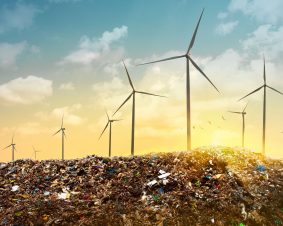 >
Spotlight April 2023: Recycling rare earths – bacteria assist in the circular economy
>
Spotlight April 2023: Recycling rare earths – bacteria assist in the circular economy
Rare earths are important components of wind turbines, catalytic converters, fibre optic cables and plasma screens. Since the 17 metals grouped under this term are indispensable for modern technologies, demand and costs are constantly rising. The occurrence of productive mining sites is limited and the production is often costly and environmentally harmful. The advantages of recycling these resources as efficiently as possible, for example from industrial waste water in the fields of mining, electronics or chemical catalysts, are obvious.
In cooperation with the University of Kaiserslautern, researchers at the Technical University of Munich have taken the circular economy of these demanded metals a huge step further: they examined several strains of cyanobacteria for their potential to bind rare earths from aqueous solution – and were successful.
The researchers determined the potential for the so-called biosorption of the rare earths lanthanum, cerium, neodymium and terbium for twelve strains of cyanobacteria. Most of these strains had never before been investigated for biotechnological potential. They come from habitats with extreme environmental conditions.
In a further project, the scientists plan to carry out the experiments on a larger scale in order to advance the industrial application of the results.
Original publication:
Michael Paper, Max Koch, Patrick Jung, Michael Lakatos, Tom Nilges and Thomas B. Brück: Rare Earths Stick to Rare Cyanobacteria: Future Potential for Bioremediation and Recovery of Rare Earth Elements. Front. Bioeng. Biotechnol., Sec. Bioprocess Engineering, Volume 11 – 2023

Weitere Spotlights
Spotlight December 2022: Fighting tumors with micro robots
When we, the DaNa team as operators of the website nanopartikel.info, write about nanobots, i.e. nanometre-sized machines, we point out that these machines belong to science fiction, may even remain a utopia – i.e. never realisable. On the significantly larger micro-scale, however, small machines are conceivable that could help in the therapy of diseases, e.g. […]
Read moreSpotlight June 2023: New catalytic process for recovering important materials from composites in a single process
Previously virtually impossible and a huge problem: fibre-reinforced resin composites (epoxides) were not recyclable, and wind turbine rotor blades, for example, add up to a waste pile of 43 million tons by 2050. Researchers have now taken an important first step in “reprocessing” these composites and catalytically dissolving them so that the carbon fibres and […]
Read moreSpotlight November 2021: Safe Materials from Scratch – Safe-by-Design in Materials Research
Advances in the field of materials science continue to amaze us with nanoscale materials with extraordinary chemical, electrical, optical, and numerous other properties. However, some nanoscale materials have different toxicological profiles compared to the same bulk material. Since safety issues are usually addressed just before launching a product into the market, safety issues may be […]
Read moreSpotlight November 2022: Photonics in nature and bioinspired designs
Science has always taken nature as a model and imitated it. If you look at the field of photonics, i.e. the use of optical technologies for information processing, transmission or storage, the colorful examples in the animal and plant world are perfect basic drawers for technical applications. While colors in nature are used either for […]
Read more

